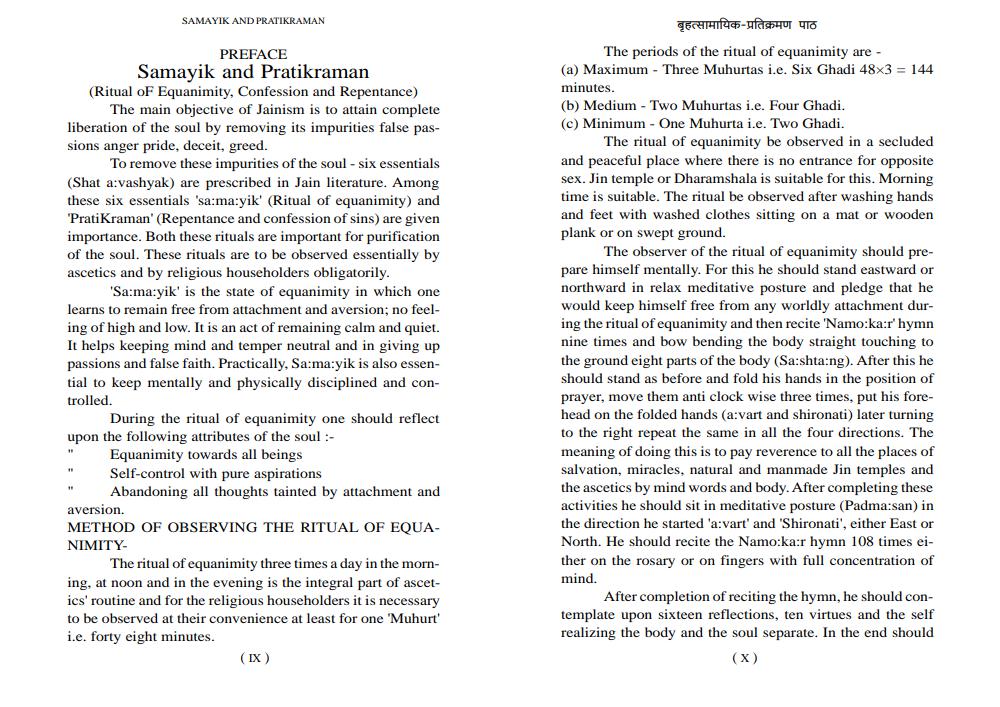Book Title: Bruhat Samayik Pratikraman Path Author(s): Subhashchand Jain, Mahendrakumar Jain Publisher: Akhil Bharatvarshiya Digambar Jain Vidvat Parishad View full book textPage 6
________________ SAMAYIK AND PRATIKRAMAN बृहत्सामायिक-प्रतिक्रमण पाठ PREFACE Samayik and Pratikraman (Ritual oF Equanimity, Confession and Repentance) The main objective of Jainism is to attain complete liberation of the soul by removing its impurities false passions anger pride, deceit, greed. To remove these impurities of the soul - six essentials (Shat arvashyak) are prescribed in Jain literature. Among these six essentials 'sa:ma:yik' (Ritual of equanimity) and "Prati Kraman' (Repentance and confession of sins) are given importance. Both these rituals are important for purification of the soul. These rituals are to be observed essentially by ascetics and by religious householders obligatorily. Sa:ma:yik' is the state of equanimity in which one learns to remain free from attachment and aversion; no feeling of high and low. It is an act of remaining calm and quiet. It helps keeping mind and temper neutral and in giving up passions and false faith. Practically, Sa:ma:yik is also essential to keep mentally and physically disciplined and controlled. During the ritual of equanimity one should reflect upon the following attributes of the soul : Equanimity towards all beings Self-control with pure aspirations Abandoning all thoughts tainted by attachment and aversion. METHOD OF OBSERVING THE RITUAL OF EQUANIMITY The ritual of equanimity three times a day in the morning, at noon and in the evening is the integral part of ascetics' routine and for the religious householders it is necessary to be observed at their convenience at least for one 'Muhurti i.e. forty eight minutes. (IX) The periods of the ritual of equanimity are - (a) Maximum - Three Muhurtas i.e. Six Ghadi 48x3 = 144 minutes. (b) Medium - Two Muhurtas i.e. Four Ghadi. (c) Minimum - One Muhurta i.e. Two Ghadi. The ritual of equanimity be observed in a secluded and peaceful place where there is no entrance for opposite sex. Jin temple or Dharamshala is suitable for this. Morning time is suitable. The ritual be observed after washing hands and feet with washed clothes sitting on a mat or wooden plank or on swept ground. The observer of the ritual of equanimity should prepare himself mentally. For this he should stand eastward or northward in relax meditative posture and pledge that he would keep himself free from any worldly attachment during the ritual of equanimity and then recite 'Namo:ka:r' hymn nine times and bow bending the body straight touching to the ground eight parts of the body (Sa:shta:ng). After this he should stand as before and fold his hands in the position of prayer, move them anti clock wise three times, put his forehead on the folded hands (a:vart and shironati) later turning to the right repeat the same in all the four directions. The meaning of doing this is to pay reverence to all the places of salvation, miracles, natural and manmade Jin temples and the ascetics by mind words and body. After completing these activities he should sit in meditative posture (Padma san) in the direction he started 'a:vart' and 'Shironati', either East or North. He should recite the Namo:ka:r hymn 108 times either on the rosary or on fingers with full concentration of mind. After completion of reciting the hymn, he should contemplate upon sixteen reflections, ten virtues and the self realizing the body and the soul separate. In the end should (X)Page Navigation
1 ... 4 5 6 7 8 9 10 11 12 13 14 15 16 17 18 19 20 21 22 23 24 25 26 27 28 29 30 31 32 33 34 35 36 37 38 39 40 41 42 43 44 45 46 47 48 49 50 51 52 53 54 55 56 57 58 59 60 61 62 ... 105
